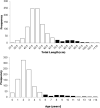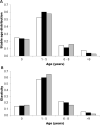From plentiful to critically endangered: Demographic evidence of the artisanal fisheries impact on the smalltail shark (Carcharhinus porosus) from Northern Brazil
- PMID: 32760084
- PMCID: PMC7410310
- DOI: 10.1371/journal.pone.0236146
From plentiful to critically endangered: Demographic evidence of the artisanal fisheries impact on the smalltail shark (Carcharhinus porosus) from Northern Brazil
Abstract
The smalltail shark, Carcharhinus porosus, was the most abundant elasmobranch species in fisheries off Brazil's northern coast (BNC) in the 1980s, but its population has been declining since the 1990s. For this reason, a demographic analysis is necessary to determine the extent of this decline and the fishing effect on the BNC's population. Therefore, we performed a stochastic demographic analysis of the population in the BNC, and considered its global center of abundance. Smalltail shark specimens (n = 937) were collected with gillnets in Maranhão state, eastern BNC, in the 1980s with sizes ranging between 29.6 and 120.0 cm total length. Most of the individuals (90.6%) caught were juveniles (< 6 years-old), and the mortality and exploitation rates showed that the species was overexploited (92.3% above the fishing mortality corresponding to the population equilibrium threshold). The smalltail shark's biological characteristics, such as slow growth and low fecundity, demonstrate that it is one of the least resilient species among similar sized coastal sharks in the region. All these factors yielded an annual decrease of 28% in the intrinsic population growth rate, resulting in a population decline of more than 90% in only 10 years, and much higher for the current period. This set of features comprising fishing recruitment occurring upon juveniles, overfishing, and intrinsically low resilience make the population unable to sustain fishing pressure and severely hamper biological recruitment, thus causing this drastic population decline. Furthermore, several local extinctions for this species in the northeastern and southeastern regions of Brazil highlight its concerning conservation scenario. Therefore, since similar fisheries characteristics occur throughout its distribution range, C. porosus fits the criteria E of the IUCN Red List for a critically endangered species and urgent conservation measures are needed to prevent its extinction in the near future.
Conflict of interest statement
The authors have declared no competing interests.
Figures





References
-
- Dulvy NK, Ellis JR, Goodwin NB, Grant A, Reynolds JD, Jennings S. Methods of assessing extinction risk in marine fishes. Fish and Fisheries 5. 255–276. Fish Fish. 2004;5:255–76.
-
- Walker TI. The state of research on chondrichthyan fishes. Mar Freshw Res. 2007;58(1):1.
-
- Santana FM, Duarte-Neto P, Lessa R. Demographic analysis of the night shark (Carcharhinus signatus, Poey, 1868) in the equatorial Southwestern Atlantic Ocean. Fish Res. 2009;100(3):210–4.
-
- Lessa R, Batista VS, Santana FM. Close to extinction? The collapse of the endemic daggernose shark (Isogomphodon oxyrhynchus) off Brazil. Glob Ecol Conserv. 2016;7:70–81. Available from: 10.1016/j.gecco.2016.04.003 - DOI
Publication types
MeSH terms
LinkOut - more resources
Full Text Sources

